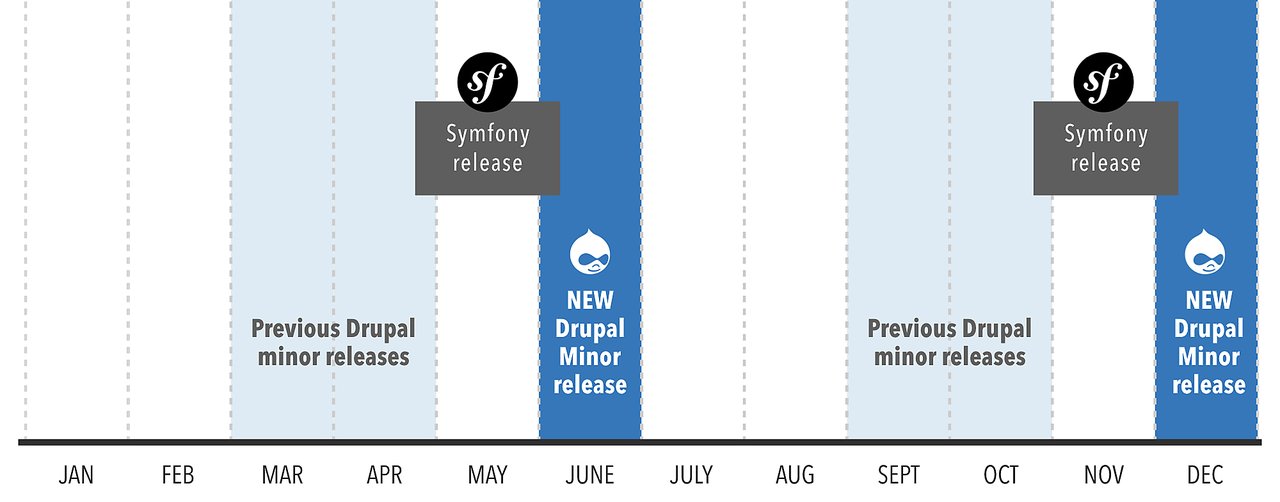Drupal is a free and open source Content Management System (CMS) that allows organizing, managing and publishing your content. This reliable and secure CMS is built on PHP based environment and powers millions of applications and websites. This tutorial will teach you the basics of Drupal using which you can create a blog or a website with ease.
Getting Started Resource Center / 10-Minute Tutorials / ...
Amazon Lightsail is the easiest way to get started on AWS. It offers virtual servers, storage, databases and networking, plus a cost-effective, monthly plan.
This tutorial shows you how to launch and configure a Drupal instance on Lightsail. It includes steps to connect to your instance by using SSH, sign in to your Drupal website, create a static IP, attach it to your instance, create a DNS zone, and map your domain to your instance.
- Drupal is a completely free website development tool that allows you to easily create, update and manage a website without requiring a lot of technical know-how. And that's not the half of it. The purpose of this site is to provide basic information and training about Drupal at UCSF.
- Dec 30, 2020 Drupal is a free, powerful content management system that lets you create custom websites, blogs, portals, and more. It has all the features you need to build a fully functional website, is highly customizable, scalable, and free to use.
- Drupal is a free, open-source content management system (CMS) with a large, supportive community. It's used by millions of people and organizations around the globe to build and maintain their websites.
- Drupal (/ ˈ d r uː p əl /) is a free and open-source web content management framework (CMF) written in PHP and distributed under the GNU General Public License. Drupal provides a back-end framework for at least 12% of the top 10,000 websites worldwide – ranging from personal blogs to corporate, political, and government sites.
| About this Tutorial | |
|---|---|
| Time | 30 minutes |
| Cost | Free Tier Eligible |
| Use Case | Compute |
| Products | Amazon Lightsail |
| Audience | Developer |
| Level | Beginner |
| Last Updated | September 11, 2020 |
This tutorial is free tier eligible.
Once you created an Amazon Lightsail account, sign into the Amazon Lightsail console.
Already have an account? Sign-in
Note: For more information about creating an instance in Lightsail, see Creating an Amazon Lightsail instance in the Amazon Lightsail documentation.
a. Choose Create instance in the Instances tab of the Lightsail home page.
b. Choose the AWS Region and Availability Zone for your instance.
c. Choose your instance image.
- Choose Linux as the platform.
- Choose Drupal as the blueprint.
d. Choose an instance plan.
A plan includes a low, predictable cost, machine configuration (RAM, SSD, vCPU), and data transfer allowance. You can try the $3.50 USD Lightsail plan without charge for one month (up to 750 hours). AWS credits one free month to your account.
e. Enter a name for your instance.
- Must be unique within each AWS Region in your Lightsail account.
- Must contain 2 to 255 characters.
- Must start and end with an alphanumeric character or number.
- Can include alphanumeric characters, numbers, periods, dashes, and underscores.

3. Connect to your instance via SSH and get the password for your Drupal website
The default password to sign in to your Drupal website is stored on the instance.
Complete the following steps to connect to your instance using the browser-based SSH client in the Lightsail console, and get the password to sign in to your Drupal website.
For more information, Getting the application user name and password for your 'Certified by Bitnami' instance in Amazon Lightsail.
a. On the Instances tab of the Lightsail home page, choose the SSH quick-connect icon for your Drupal instance.
b. After the browser-based SSH client window opens, enter the following command to retrieve the default application password:
c. Make note of the password displayed on the screen. You use it later to sign in to the administration dashboard of your Dupral website.
Within minutes, your Drupal instance is ready, and you can connect to it using the browser-based SSH client in the Lightsail console.
Now that you have the password for your Drupal website, you can sign in. In the administration dashboard, you can change your user password, install plugins, change the theme of your website, and more.
Complete the following steps to sign in to the administration dashboard of your Drupal website.
Note: For more information, Getting the application user name and password for your 'Certified by Bitnami' instance in Amazon Lightsail.
In the address, replace PublicIpAddress with the public IP address of your Drupal instance. You can get your instance's public IP address from the Lightsail console as shown in the following image:
b. Log into your site.
- In the Username box, enter user.
- In the Password box, enter the default password obtained earlier in this tutorial.
- Choose Log in.
You are now signed in to your Drupal website where you can perform administrative actions. For more information about administering your Drupal website, see the Drupal User Guide in the Drupal documentation.
5. Create a Lightsail static IP address and attach it to your Drupal instance
The default public IP for your Drupal instance changes if you stop and start your instance. A static IP address, attached to an instance, stays the same even if you stop and start your instance.

Complete the following steps to create a static IP address and attach it to your Drupal instance.
Note: For more information, see Create a static IP and attach it to an instance in Amazon Lightsail.
b. Choose the Networking tab, the choose Create static IP.
6. Create a Lightsail DNS zone and map a domain to your Drupal instance
Transfer management of your domain's DNS records to Lightsail. This allows you to more easily map a domain to your Drupal instance, and manage more of your website’s resources using the Lightsail console.
Drupalcon
Complete the following steps to create a Lightsail DNS zone and map a domain to your Drupal instance.
Note: For more information, see Creating a DNS zone to manage your domain’s DNS records in Amazon Lightsail.
- In the DNS zone for your domain, choose Add record.
- In the Subdomain box, enter an @ symbol to map the apex of your domain (such as example.com) to your instance. The @ symbol explicitly symbolizes that you’re adding an apex record. It is not added as a subdomain.
- In the Maps to box, choose the static IP that you attached to the Drupal instance in the previous step of this tutorial.
- Choose the save icon.
- Allow time for the change to propagate through the internet's DNS before your domain begins routing traffic to your Drupal instance.
You have used Amazon Lightsail to launch and deploy a Drupal instance.
Amazon Lightsail is a great choice to develop, build, and deploy a variety of applications like Drupal, websites, and other blog platforms.
Was this tutorial helpful?
Recommended next steps
Learn more

Drupal 8

Create a snapshot
Attach a disk
reference deployment
Deploy Drupal using Amazon RDS, Amazon S3, and other AWS services
What Is Drupal
This Quick Start deploys a highly available Drupal architecture on the Amazon Web Services (AWS) Cloud.
Drupalcon 2021
Drupal is an open-source, content management platform written in the PHP server-side scripting language. Drupal provides a backend framework for many enterprise websites. Deploying Drupal on AWS makes it easy to use AWS services to further enhance the performance and extend functionality of your content management framework.
The deployment uses Amazon Elastic Compute Cloud (Amazon EC2), Amazon Virtual Private Cloud (Amazon VPC), Amazon Relational Database Service (Amazon RDS), Amazon Elastic File System (Amazon EFS), Amazon ElastiCache, Amazon CloudFront, and Amazon Route 53.
This reference architecture is automated by AWS CloudFormation templates that deploy the Drupal environment on AWS in about 30 minutes. You can customize the templates to meet your specific requirements.
This Quick Start was developed by
AWS solutions architects.
- What you'll build
Use this Quick Start to set up the following Drupal environment on AWS:
- A virtual private cloud (VPC) that is configured across two Availability Zones. For each Availability Zone, this Quick Start provisions one public subnet and one private subnet, according to AWS best practices.*
- In the public subnets, Linux bastion hosts in an AWS Auto Scaling group to provide secure access to allow inbound Secure Shell (SSH) access to Amazon EC2 instances in the private subnets.*
- In the public subnets, managed network address translation (NAT) gateways to provide outbound internet connectivity for instances in the private subnets.*
- In the private subnets, a web server instance (Amazon Machine Image, or AMI) in an AWS Auto Scaling group to host the Drupal servers and Amazon Aurora database instances.
- AWS Auto Scaling, which allows the Drupal cluster to add or remove servers based on use.
- Integration of AWS Auto Scaling with Elastic Load Balancing, which automatically adds and removes instances from the load balancer. The default installation sets up low and high CPU-based thresholds for scaling the instance capacity up or down.
- Amazon Elastic File System (Amazon EFS), which provides simple, scalable file storage for use with Amazon EC2 instances.
- An AWS Identity and Access Management (IAM) role to enable AWS resources created through the Quick Start to access other AWS resources when required.*
- Amazon ElastiCache for caching database queries and Drupal sessions.
- Amazon CloudFront as the content delivery network to speed up distribution of static and dynamic content from Drupal to end users.
- Amazon Route 53 as your public Domain Name System (DNS) for resolving the domain name of your Drupal site.
* The template that deploys the Quick Start into an existing VPC skips the tasks marked by asterisks and prompts you for your existing VPC configuration.
- A virtual private cloud (VPC) that is configured across two Availability Zones. For each Availability Zone, this Quick Start provisions one public subnet and one private subnet, according to AWS best practices.*
- How to deploy
You can build your Drupal environment on AWS in about 30 minutes, by following the instructions in the deployment guide. The deployment process includes these steps:
- If you don't already have an AWS account, sign up at https://aws.amazon.com.
- Launch the Quick Start. You can choose from two options:
- Log in to the Drupal administrator site to test your deployment.
- Use the Drupal administrator site to create content.
The Quick Start includes parameters that you can customize to best meet your business, IT, and security requirements.
Amazon may share user-deployment information with the AWS Partner that collaborated with AWS on the Quick Start.
- Cost and licenses
This deployment launches Drupal 7 or Drupal 8 automatically into a configuration of your choice. Drupal is open-source software. It is licensed under GNU GPL version 2. For additional details about Drupal’s licensing, see the Drupal website.
You are responsible for the cost of the AWS services used while running this Quick Start reference deployment. There is no additional cost for using the Quick Start. See the pricing pages for each AWS service you will be using for cost estimates.
The AWS CloudFormation templates for this Quick Start include configuration parameters that you can customize. Some of these settings, such as instance type, will affect the cost of deployment. See the pricing pages for each AWS service you will be using for cost estimates.
